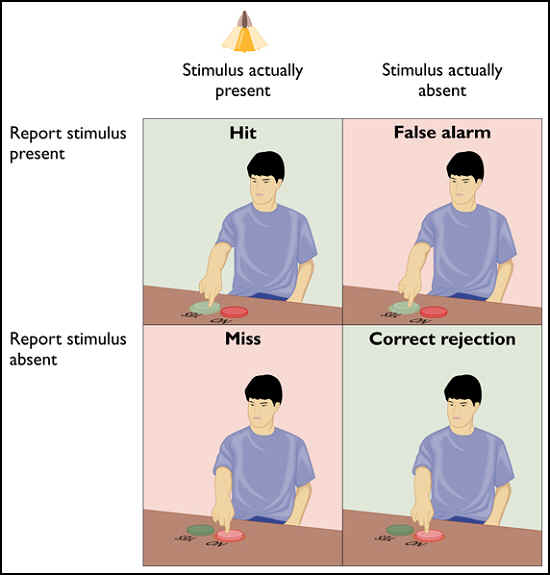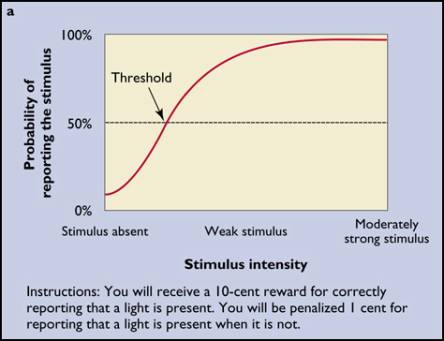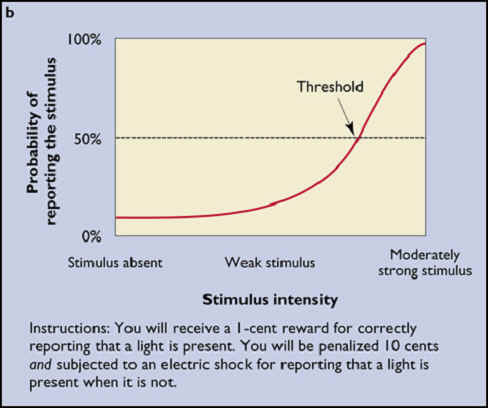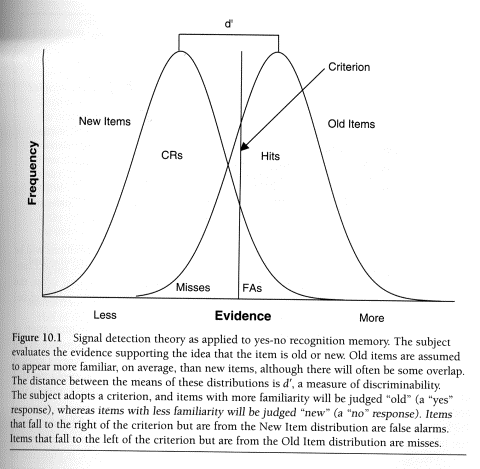
Psy
342 Learning & Memory
Factors
Contributing to Successful Retrieval
(Chapter
10)
I. Recognition Memory
A.
Types of tests
Recognition
test—target is provided; context must be retrieved by S.
Recall test--context is provided; target has to be retrieved by S.
1.
Forced choice recognition tests—four alternatives are provided in a 4AFC test.
Can
manipulate type and number of distractors.
Can
obtain details regarding types of errors made by Ss.
Recognition
scores reflect factors other than just degree of learning. Number
of targets detected is influenced by number and nature of the distractors.
2.
Yes-no recognition test—Ss see/hear study list and then on test list must
indicate whether item appeared on study list (old) or did not appear on study
list (new).
There
are four possible responses (2 correct and 2 incorrect).

Response
bias can play large role in altering Ss’ behavior, which is independent of
their actual ability discriminate between old and new items.



B. Signal Detection
Theory
Original
situation—S’s detected the presence of a signal (tone, for example) when
presented against a background noise. Two
possible situations—noise only OR signal + noise.
Basis
of S’s response—(1) true
ability to discriminate signal + noise from noise only and (2) response bias.

d’
is measure of pure discriminability (difference between the averages of the old
and new item distributions).
II.
Models
A.
Single process models
Tagging
model of recall and recognition--each item is tagged when it occurs.
Strength
theory—the more recent an item, the more familiar it seems.
Problem—these
models propose only a single process.
B.
Generate-recognize models
A
word is presented to S and some form of change will occur at word node (leaving
a tag).
Recall
involves two processes: (1) generation of possible candidate words and (2)
recognizing previously presented words (detecting tag).
Recognition
depends mainly on detecting the markers.
Prediction--Recall
would be harder than recognition because it involves an extra stage.
Also
explains frequency effect with recall and recognition.
Recall
is better for high-frequency words because they’re easier to generate.
Recognition is worse for high-frequency words because these words are
more likely to have tags from sources outside of the experiment.
Kintsch
(1968)--Presenting organized material enhances recall much more than it enhances
recognition because organization is important in generation.
Problem
with generate-recognize—if a word can be recalled, it must also be recognized.
Tulving
has demonstrated recognition
failure of recallable words.
III. Encoding Specificity—ease of retrieval depends on the match between the way information is encoded and later retrieved. Try this
Tip: Study and review under varying conditions with substantial intervals between study sessions
A. Why does the match between encoding and retrieval influence the ease with which people can access information from memory?
B. Strong cue vs. weak cue
Strong cue—word that elicits a desired target word most of the time.
Weak cue—word that elicits the target word only rarely.
Thomson and Tulving (1970) presented some target words alone at study, and some with a weak cue. At test, there were three cue conditions: no cue, a weak cue, or a strong cue.

Results--a strong cue can be effective (e.g., no study cues provided and Ss were expecting a free recall test). When a weak cue was presented at encoding, the weak cue at test was better than both no cue and the strong cue.
C. Context and Memory
Context dependent memory effect—memory can be worse when tested in a new or different context compared to performance when context stays the same for encoding and test.
Abernathy (1940)
Smith (1979)
D. State-dependent memory—memory can be worse when tested in a different state compared to performance when S’s state stays the same for encoding and test.
Goodwin et al. (1969) demonstrated state-dependent memory using alcohol.

Why does a shift from intoxication to sobriety impair memory more than a shift from sobriety to intoxication?
What is encoded?